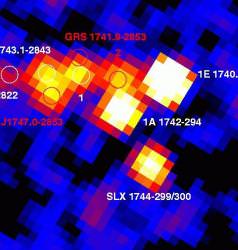 For a brief time in April 2006, the active region surrounding the supermassive black hole at the heart of the Milky Way settled down. Ten different sources of high energy rays all faded away temporarily, and ESA’s Integral probe was able to capture images of less bright regions, which weren’t completely obscured by the bright objects in their vicinity.
For a brief time in April 2006, the active region surrounding the supermassive black hole at the heart of the Milky Way settled down. Ten different sources of high energy rays all faded away temporarily, and ESA’s Integral probe was able to capture images of less bright regions, which weren’t completely obscured by the bright objects in their vicinity.
Integral normally keeps track of about 80 bright X-ray objects near the galactic core. These are mostly X-ray binaries, where a regular star is locked in orbit with a collapsed star, like a white dwarf, neutron star, or even black hole. If the two objects are close enough, gas is pulled off the star, and spirals onto the collapsed partner. This material heats up to over a million degrees, and causes it to emit high energy X-rays.
It was a completely random event that these normally bright objects dimmed down briefly, but astronomers jumped at the opportunity to look for fainter objects which are normally obscured. They’re hoping to turn up additional X-ray binaries, or high-energy radiation from giant molecular clouds. They might even be able to detect high-energy radiation around the Milky Way’s supermassive black hole.
Original Source: ESA News Release
